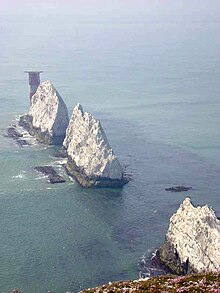| Chalk Group | |
|---|---|
| Stratigraphic range: Cenomanian to Maastrichtian, | |
 Brass Point, one of the Seven Sisters | |
| Type | Group |
| Sub-units | Cambridge Greensand Grey Chalk Subgroup, White Chalk Subgroup |
| Underlies | unconformity, Thanet Formation, Lambeth Group |
| Overlies | Selborne Group, Hunstanton Formation, Cambridge Greensand |
| Thickness | over 1,500 m (4,900 ft) |
| Lithology | |
| Primary | limestone |
| Other | mudstone, flint |
| Location | |
| Country | England |
| Extent | southern and eastern England |
The Chalk Group (often just called the Chalk) is the lithostratigraphic unit (a certain number of rock strata) which contains the Upper Cretaceous limestone succession in southern and eastern England. The same or similar rock sequences occur across the wider northwest European chalk 'province'. It is characterised by thick deposits of chalk, a soft porous white limestone, deposited in a marine environment.
Chalk is a limestone that consists of coccolith biomicrite.[1] A biomicrite is a limestone composed of fossil debris ("bio") and calcium carbonate mud ("micrite"). Most of the fossil debris in chalk consists of the microscopic plates, which are called coccoliths, of microscopic green algae known as coccolithophores. In addition to the coccoliths, the fossil debris includes a variable, but minor, percentage of the fragments of foraminifera, ostracods and mollusks. The coccolithophores lived in the upper part of the water column. When they died, the microscopic calcium carbonate plates, which formed their shells settled downward through the ocean water and accumulated on the ocean bottom to form a thick layer of calcareous ooze, which eventually became the Chalk Group.
The Chalk Group usually shows few signs of bedding, other than lines of flint nodules which become common in the upper part. Nodules of the mineral pyrite also occur and are usually oxidized to brown iron oxide on exposed surfaces.
Well-known outcrops include the White Cliffs of Dover, Beachy Head, the southern coastal cliffs of the Isle of Wight and the quarries and motorway cuttings at Blue Bell Hill, Kent, (which has been classified as a Site of Special Scientific Interest) and at the Stokenchurch Gap on the Oxfordshire/Buckinghamshire border where the M40 motorway cuts through the Aston Rowant National Nature Reserve.


- ^ As discussed in Chalk Facts by C. S. Harris and Scholle et al. (1983)
© MMXXIII Rich X Search. We shall prevail. All rights reserved. Rich X Search
